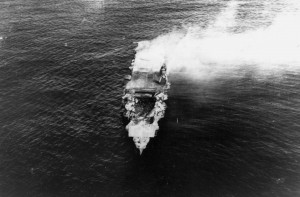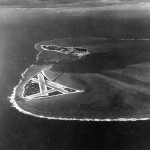
Published on June 5, 2012
Exactly seventy years ago today, the Battle of Midway was fought. It was the turning point of the war in the Pacific against the Japanese. The first months of America’s involvement in World War II had been a dark time. The Japanese had only just struck Pearl Harbor on December 7, 1941. On December 8, America formally entered the War. In short order, the Japanese attacks multiple islands and nations across the Pacific ranging from the Philippines, to the island chain of the Coral Sea, where a major naval engagement took place that saw both sides suffer losses but did not come away with any clear victor.
The first good news was five months coming. In April 1942, Doolittle’s raiders bombed Japan in a surprise attack, taking off from the deck of the American aircraft carrier Hornet. While the mission did small damage to Japan’s war industry and military might, strategically it was a huge victory for America. After just five months of war, with nothing but bad news, Doolittle’s raid was touted as a turning point — yet among military planners, they knew that things were far from decided. Events in the Pacific were unfolding quickly as the navies of each country deployed their forces for a showdown in the vast expanse of the ocean that separated the combatants. Only then would the future be decided.
As James R. Schlesinger, former Secretary of Defense, remarked on the 61st anniversary of the battle:
Japan was on a roll. The Philippines had fallen, including the final outposts of Bataan and Corregidor. The Japanese had swept down through the Malay Peninsula from French Indochina, and on 15 February, the supposedly “impregnable fortress” of Singapore had fallen–to numerically inferior Japanese forces. The Dutch East Indies had been captured. Japanese forces were advancing into Burma and might proceed to India. Even Australia appeared to be threatened. American naval forces, significantly weakened by the attack at Pearl Harbor, appeared vastly inferior to the armada that Japan was gathering to advance eastward in the Pacific toward Midway–and then possibly to the Hawaiian Islands or even the West Coast. Additional Japanese victories would have made it politically impossible for Roosevelt to continue to pursue the Grand Strategy of Europe-first.
Then came Midway.
The Battle of Midway is Fought
From June 4 to June 7, 1942, just six months into the war, the pivotal engagement was fought near Midway Atoll. This little island atoll was strategically located and could serve the Japanese as they continued their expansion eastward toward Hawaii. In terms of size, it was insignificant — in terms of location, second only to Hawaii, it was the key strategic site of the Pacific War at that point of time. Midway itself was composed of several islands and Eastern Island held the airfield — testimony to the small size of the islands, the airfield took up all of the space on the island itself. Nearby Sand Island, also part of the Midway Atoll, housed most of the base and administrative buildings.

Unbeknownst to the Japanese, in the months before the battle, American code breakers in Washington, DC, had cracked the Japanese message traffic. Knowing where and when the Japanese would strike next was essential. Knowing the Japanese plans, the American Naval forces mustered the full strength of their carrier forces to intercept the Japanese in what was hoped to be a single, decisive engagement. If victorious, the sea battle would turn the tide of the Pacific.
The Battle of Midway was also the second major naval engagement to prove that the era of battleships and cruisers had been eclipsed by the power of airplanes. For the Americans, there was no choice — all of the Pacific Fleet’s great battleships and cruisers had been casualties at Pearl Harbor. In the battle that ensued, not a single ship engaged in direct combat — instead, as had happened in Pearl Harbor — the battle was fought solely by carrier-borne aircraft, a mix of fighter planes, dive bombers and torpedo bombers. It was also the battle that proved that the power of code-breaking, above all else.
The Battle of Midway could have gone either way. Japanese efforts were initially targeted against Midway Atoll itself. They had no idea where or if the American fleet might be and the plan was simple — attack the atoll and then take it by invasion. The first attacks against the island were launched. The American defenders launched their airplanes to defend the airfield. They were swept clear by the numerically superior Japanese fighter planes and the bombers rolled in. Soon the island was afire, smoke filled the skies and the Japanese planes returned to their carriers to rearm for a second strike.
Then, unexpectedly, Japanese reconnaissance planes spotted the American fleet. Quickly, the aircraft were rearmed for a strike against the American carrier power. If they could strike first and destroy the America carriers, the entire Pacific war would be decided. Yet unbeknownst to the Japanese, the Americans had also spotted the Japanese fleet. The US Navy’s own air strikes were already inbound as the Japanese raced to rearm and reload their planes for their own strike.
The first American attacks arrived piecemeal against the Japanese fleet, which had not been the plan. Quickly, the Japanese defensive air cover moved into action. Many aircraft were lost and no hits scored. To the Japanese, it seemed that the American forces were soon going to be overwhelmed. The Japanese defensive fighters landed on the carriers to rearm and refuel leaving the skies open and the fleet unprotected by air cover.
As related by Commander Mitsuo Fuchida, the entire battle was decided as a result of a single five minute period. He later wrote:
Preparations for a counter-strike against the enemy had continued on board our four carriers throughout the enemy torpedo attacks. One after another, planes were hoisted from the hangar and quickly arranged on the flight deck. There was no time to lose. At 1020 Admiral Nagumo gave the order to launch when ready. On Akagi’s flight deck all planes were in position with engines warming up. The big ship began turning into the wind. Within five minutes all her planes would be launched.
Five minutes! Who would have dreamed that the tide of battle would shift completely in that brief interval of time?
Visibility was good. Clouds were gathering at about 3,000 meters, however, and though there were occasional breaks, they afforded good concealment for approaching enemy planes. At 1024 the order to start launching came from the bridge by voice-tube. The Air Officer flapped a white flag, and the first Zero fighter gathered speed and whizzed off the deck. At that instant a lookout screamed: ‘Hell-divers!’ I looked up to see three black enemy planes plummeting toward our ship. Some of our machine guns managed to fire a few frantic bursts at them, but it was too late. The plump silhouettes of the American ‘Dauntless’ dive-bombers quickly grew larger, and then a number of black objects suddenly floated eerily from their wings. Bombs! Down they came straight toward me! I fell intuitively to the deck and crawled behind a command post mantelet.
The terrifying scream of the dive-bombers reached me first, followed by the crashing explosion of a direct hit. There was a blinding flash and then a second explosion, much louder than the first. I was shaken by a weird blast of warm air. There was still another shock, but less severe, apparently a near miss. Then followed a startling quiet as the barking of guns suddenly ceased. I got up and looked at the sky. The enemy planes were already gone from sight.
The attackers had gotten in unimpeded because our fighters, which had engaged the preceding wave of torpedo planes only a few moments earlier, had not yet had time to regain altitude.
Consequently, it may be said that the American dive-bombers’ success was made possible by the earlier martyrdom of their torpedo planes. Also, our carriers had no time to evade because clouds hid the enemy’s approach until he dove down to the attack. We had been caught flatfooted in the most vulnerable condition possible — decks loaded with planes armed and fueled for attack.
Looking about, I was horrified at the destruction that had been wrought in a matter of seconds. There was a huge hole in the flight deck just behind the amidship elevator. The elevator itself, twisted like molten glass, was drooping into the hangar. Deck plates reeled upward in grotesque configurations. Planes stood tail up, belching livid flame and jet-black smoke. Reluctant tears streamed down my cheeks as I watched the fires spread, and I was terrified at the prospect of induced explosions which would surely doom the ship.
Ultimately, the Japanese were able to strike back with their remaining forces — one US carrier was heavily damaged as well as several other ships in the fleet. However, subsequent American attacks sank more of the Japanese aircraft carriers. Badly beaten, the rest of the Japanese fleet retreated westward to disengage. The victory of the US Navy was complete and clear.
So it was that on June 5, 1942, exactly 70 years ago, the fate of the Pacific and of the war was decided. When the battle was over, Japan had lost four of its aircraft carriers. It was a devastating blow from which the Japanese Navy never recovered. After the Battle of Midway, the outcome of the war in the Pacific would take another three years of grinding island warfare to finally reach victory. Never again would the Japanese carrier forces engage the Americans. US forces would steadily advance westward, island hopping across the Pacific to finally reach striking range of the Japanese main islands. From the far western islands of Guam, the atomic bomb would decide the war’s end.
